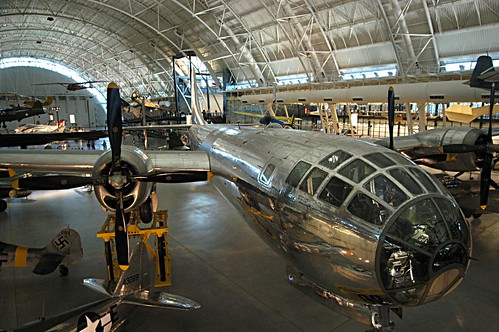I’ve been mulling over the old question of what Walter Benjamin called aura. During the few days we were down in Virginia, DC & Baltimore last week, I noted that some of my largest adrenalin rushes – of some decidedly different types – came not from seeing the work of Marcel Duchamp or George Grosz at the National Gallery, or even the breathtaking array of artifacts at the National Museum of the American Indian (nor, for that matter, from its architecture, all southwestern on the outside and a direct ripoff of Frank Lloyd Wright’s Guggenheim Museum on the inside), but from a relatively small woman and two flying machines.
The woman was Sandra Day O’Connor, whom Krishna and I and the boys almost walked right into as she was posing for some photos in front of the Freer Gallery at the Smithsonian. She was smaller than I’d imagined & impeccably dressed – she could have gone on television with no further make-up. We stopped so as not to interrupt the photo shoot – the camera man had serious equipment, so I presume he was a professional – and after two or three shots, she climbed into her limo and was driven away.
The flying machines were out next to
One of the two machines that did cause an immediate visceral reaction from me was the Enterprise, an early “test” version of the
The other is the Enola Gay. Pictured above as it sits in the Air & Space museum, this is the plane that dropped the atomic bomb on
All of these sightings involve complex emotions. Sandra Day O’Connor was a rightwing politician, both before and on the U.S. Supreme Court. She is the reason that George W. Bush became president of the
The space shuttle evoked pure awe in me – its scale feels so large and the project of making such a complex human object is so daunting, especially when the slightest error in an o-ring or bit of foam sends astronauts to instant death, that you can’t look at it without sensing the scope of human ambition it represents. There certainly are times when I think that space exploration is the one legitimate use of our military, even tho NASA itself is curiously positioned astraddle the military-civilian line. But it’s not an accident that the first thing we did when we got to the museum was sit through an IMAX movie on Roving Mars, featuring footage from robots doing exactly that.
But the most complicated – conflicted – response I had came to the Enola Gay. From a distance, this B-29 Superfortress doesn’t stand out in a space that contains the Shuttle, the Concorde, a Stealth Bomber, several racing jets from the 1920s & ‘30s, some very early helicopters, even a FedEx airplane. By World War 2 standards, however, a B-29 is huge – 99 feet front to back with a wingspan of more than 141 feet. The name Enola Gay carries with it so much terrible history, tho it is worth noting that the devastation unleashed upon
Restored, literally glistening as if it just came off the Boeing assembly line, the Kelly green leather seats of its cockpit thoroughly polished, the Enola Gay is a bizarre monument to find in a museum that celebrates the potential of flight, as if to remind us of its worst possible consequences as well (there are some missiles & drones alongside the Shuttle in the next wing, tho next to it they look like toothpicks). The Enola Gay fills you – or fills me anyway – with wave after wave of emotion, ranging from the most abstract – numbers, images from documentaries – to others very personal (the fact that when I was born, my parents lived in Navy housing constructed for the Manhattan Project, or that my father was sent to Nagasaki a month after the bombing there, bringing in aid to a now captive nation).
Benjamin associates the object’s aura with presence, a kind of immanence, but I’m not so certain. What separates Sandra Day O’Connor from the next white-haired lady I pass on the street is what I know about her, even if the impeccable presentation, the perfect hair & royal blue dress suitable for meeting heads of state, separates her out visually from her immediate surroundings. It is also true that what I know about the Enola Gay is what separates it from any other vintage aircraft. Only the scale of the space shuttle, itself something of an optical illusion – there’s no 747 here, the Concorde’s half-hidden in the next bay by other aircraft, you first see the shuttle nose pointing directly at you – really creates that visceral sense I think of as recognition combined with presence.
It’s thoroughly arguable, of course, that my reactions prove Benjamin’s point in the first place. Aura, as Benjamin outlines it in “The Work of Art in the Age of Mechanical Reproduction,” is something much closer to a Zen experience: be here now with this humble stone, petal, spider, whatever. Of all cities in
Perhaps this is what Larry Fagin is getting at when he argues that it would be good for poems to be published anonymously, in that it would erase that discursive layer. You couldn’t tell whether a poem were by Jim Behrle or Curtis Faville. But my experience, both in Virginia & DC last week & here when I confront a poem on the web or on paper is that these layers, even tho they may be discursive, are not extraneous. History is integral to experience. The rose is itself a product of history, the Mayans turned corn from something akin to a foxtail or bur into the great grain crop of






